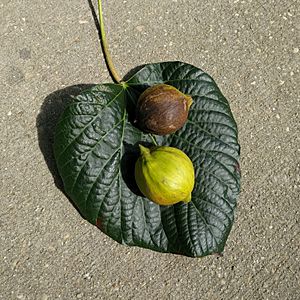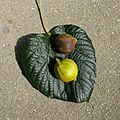Tung oil facts for kids
Quick facts for kids Tung oil |
|
|---|---|
| IUPAC name | tung oil |
| Other names | China wood oil; lumbang oil; tung oil paraformaldehyde; tungmeal; tungoel |
| Identifiers | |
| CAS number | |
| EC number | 232-272-3 |
| Properties | |
| Molecular formula | |
| Molar mass | 0 g mol-1 |
| Density | 0.937 g/ml at 25°C |
| Refractive index (nD) | 1.52 (20°C) |
| Hazards | |
| Flash point | >110°C |
| Except where noted otherwise, data are given for materials in their standard state (at 25 °C, 100 kPa) | |
Tung oil, also known as China wood oil, is a special type of oil. It comes from pressing the seeds found inside the nuts of the tung tree (Vernicia fordii). People believe this oil and its uses first started in ancient China. It was even mentioned in the writings of Confucius around 400 BC.
Tung oil is a "drying oil." This means it gets hard when it touches air. This happens through a process called polymerization, where tiny parts of the oil link together. The coating it forms is clear and looks very smooth, almost wet. It is mostly used to protect and make wood look good. After many layers, the finish can even look a bit like plastic. Other oils that dry in a similar way include linseed oil, safflower oil, poppyseed oil, and soybean oil.
Sometimes, raw tung oil can dry with a wrinkled surface. This was even used to create special "wrinkle finishes." To stop this from happening, the oil is often heated. This process is sometimes called "boiling" the oil. It makes the oil dry smoothly.
The name "tung oil" is also often used by companies that make paints and varnishes. They might use it for any wood-finishing product that contains real tung oil. Or, they might use it for products that just give a similar look to a tung oil finish.
Contents
History of Tung Oil
The tung oil tree originally comes from southern China. People there grew it to get tung oil a very long time ago. We don't know exactly when they started growing it. During the Song Dynasty in China, tung oil was used to make ships waterproof. This helped the ships stay dry and float better. The word "tung" comes from the Chinese word tóng. The earliest mentions of tung oil in China are from the writings of Confucius, who lived between 500 and 400 BC.
What Is Tung Oil Made Of?
Tung oil is mostly made up of special types of fats called fatty acids. The table below shows the main fatty acids found in tung oil and how much of each there is.
| Alpha-eleostearic acid | 82.0% |
| Linoleic acid | 8.5% |
| Palmitic acid | 5.5% |
| Oleic acid | 4.0% |
The most important part of tung oil is a fatty acid with 18 carbon atoms linked together. These atoms have three special connections called "double bonds." These double bonds are very sensitive to air. When they touch air, they help the oil harden by linking up with other oil parts. This is what makes the oil dry and form a strong coating.
How Is Tung Oil Used?
Protecting Wood with Tung Oil
Tung oil is very popular today for a few reasons. First, it comes from a natural source, the tung tree. Second, once it dries, it creates a very hard finish that can be easily fixed if it gets damaged. It takes about 5 to 30 days for the oil to fully dry, depending on the weather. Because it's so strong, it's often used on boat decks and even on floors.
The oil is often made thinner by mixing it with a special liquid. This makes the oil less thick, so it can soak deep into the tiny spaces of wood. This thinning liquid then disappears in about 15 to 20 minutes. When you put many thin layers of tung oil on wood, it slowly dries to a soft, slightly shiny look with a light golden color. Tung oil is also better at resisting water than most other pure oil finishes. It also doesn't get much darker as it gets older. Some people say it resists mold better than linseed oil. It is even considered safe to use on sculptures placed near water.
Heating tung oil to about 500 °F (260 °C) (260°C) without oxygen makes it much thicker. It also helps it form a better film. Most tung oils that have been heated like this are sold mixed with a liquid called mineral spirits. This makes them easier to use. Other safer liquids like Limonene can also be used instead of mineral spirits.
Tung Oil in Oil-Paper Umbrellas
The oil-paper umbrella is a very old and traditional umbrella. It has been used for centuries in China, Japan, and other countries in Asia. These umbrellas came to Western countries through the famous Silk Road. Tung oil is the "oil" that gives the oil-paper umbrella its name. It is used to protect the paper from getting wet. This makes the umbrella waterproof and useful in the rain.
How to Apply Tung Oil
A common way to put pure tung oil on wood is to mix it with an equal amount of a special thinner. Then, you use a soft, lint-free cloth, like a piece of an old T-shirt, to apply very thin layers. The liquids used to thin the oil can be traditional turpentine or newer citrus-based thinners. The choice of thinner depends on how fast you want the oil to dry.
For the first layers, you can use a 1:1 mix of oil to thinner. If the wood doesn't soak up the oil as much in later layers, you can use more thinner. This method helps bring out the deepest color of the wood. It also keeps the finish looking natural and not too shiny.
When using tung oils that have been heated or special tung oil mixes, it's best to follow a rule called "fat over lean." This means you first apply thin oil to soak into the wood and fill its tiny holes. Then, you apply a moderate amount of pure oil. This layer sticks to the surface and creates a good base for thicker, shinier layers.
Finally, a thick layer of the heated tung oil is applied. Let it dry completely. Then, make it smooth using very fine sandpaper and very fine steel wool. Wipe the surface clean with a damp cloth and let it dry again. For the last coat, apply it fairly thickly. The oil will smooth itself out to look like glass. Let this final coat dry for two to three days. It is very important to know that rags soaked with tung oil can sometimes catch fire on their own. Always spread out used rags to dry or put them in a sealed, water-filled container.
Images for kids





